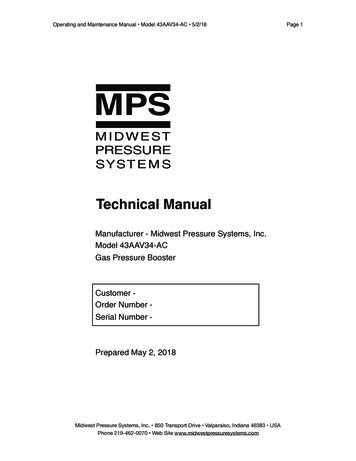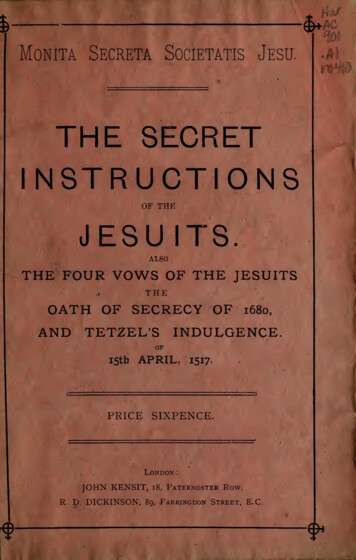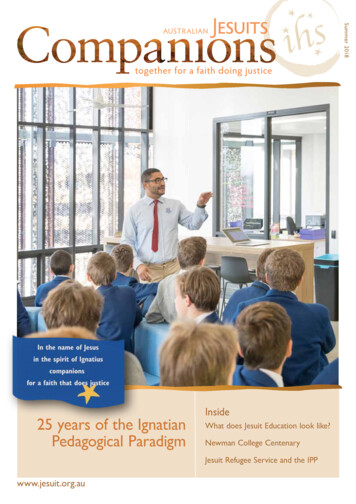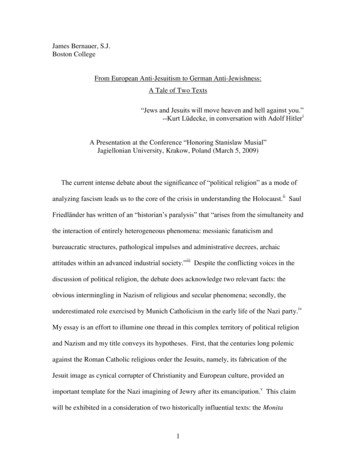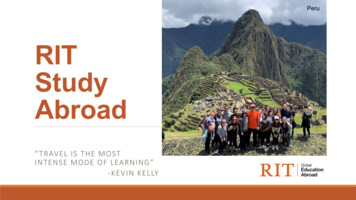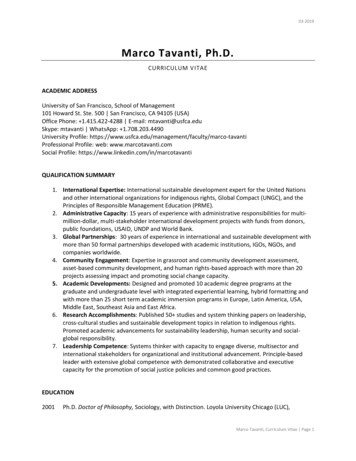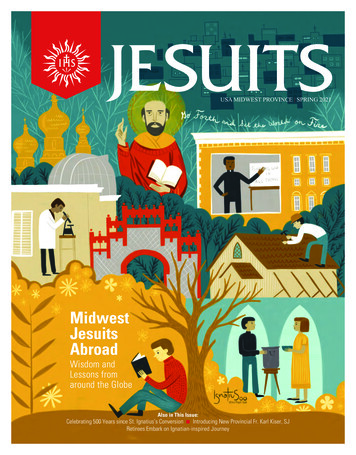
Transcription
USA MIDWEST PROVINCE SPRING 2021MidwestJesuitsAbroadWisdom andLessons fromaround the GlobeAlso in This Issue:Celebrating 500 Years since St. Ignatius’s Conversion n Introducing New Provincial Fr. Karl Kiser, SJRetirees Embark on Ignatian-inspired Journey
Dear Friends,I am humbled.These are the words I used when I wrote my first message in this magazine as the first provincial of thenewly formed USA Midwest Province. And they are just as true today—in this, my last message to youas provincial in Jesuits Magazine. I have been humbled to work with my Jesuit brothers and our laycollaborators to pursue our mission, and I have been humbled to experience the fruits of your prayersand support in all that we do.I am pleased that Father General Arturo Sosa, SJ, has named Fr. Karl Kiser, SJ, as our next provincial(see page 12). A proven leader, Fr. Kiser brings considerable pastoral and administrative gifts, alongwith international experience, to his role of caring for the Jesuits and the ministries of our province. Iam equally grateful for his deep and abiding love for the Society of Jesus and its service to the Church.One such mutual goal involves the Truth, Racial Healing, and Transformation dialogue that hasbeen taking place among the Society of Jesus, Georgetown University, and the Descendants ofJesuit Slaveholding (page 9). President of the Jesuit Conference, former Chicago-Detroit ProvincialTimothy Kesicki, SJ, has been engaged in this vital work for several years; it is just now bearingfruit. The Descendants have invited us to partner with them on a common project—their vision of anew charitable foundation. While much work remains, this is an important moment as we embrace apartnership that seeks progress in healing racial divisions. If you are so moved, I invite you to join us insupporting this ambitious and important project which flows from the heart of the gospel.Briefly, this magazine has much more good news to share: a new program called the Ignatian LegacyFellows (page 6); our cover story (page 8), which provides perspectives from Midwest Jesuits who areserving abroad; an up-and-coming playwright (page 13); a student leader in activism and social justice(page 16); and several food industry professionals who have improvised during the pandemic (page20).Finally, we are celebrating as we embark on the Ignatian Year (page 4), which begins on May 20—the 500th anniversary of the date a cannonball hit Iñigo de Loyola and forever changed his life. Thisjubilee will be an opportunity to rediscover our roots, while considering the “cannonball moments”in our own lives, through which we might hear Godcalling us to our own conversion, as we endeavor “tosee all things new in Christ.”It is my prayer that you might experience suchtransformation as you ever deepen your relationshipwith God. And it is my fervent prayer that youknow how grateful we are for your support of andparticipation in our mission.In Christ,V. Rev. Brian G. Paulson, SJProvincial, USA Midwest Province
MIDWEST USA MIDWEST PROVINCESpring 2021Evangelizing Through DramaPage 13ON THE COVERMidwest Jesuits are presently servingand studying in every corner of theworld, as the Society of Jesus hasdone for centuries. Many of the localesmentioned in the story can be found onthe cover. How many can you find?Illustration: Jacqui LangelandImanol Ruiz, graduate of Cristo Rey Jesuit High Milwaukee, emphasizes the importance of his Jesuiteducation in his success as a playwright.Photo: Jeff ZmaniaFor additional content and moreinformation, connect with us online:WWW.JESUITSMIDWEST.ORGSearch “Midwest Jesuits” on Facebook,Twitter, YouTube, Pinterest, LinkedIn, and InstagramPage 8Page 12Close Encounters of the Global KindMidwest Jesuits share lessons andreflections from their time abroad.Passing the Torch to Set the World onFireAs the V. Rev. Brian Paulson, SJ, takeson the role of president at the JesuitConference of Canada and the UnitedStates, the Midwest Jesuits welcomeFr. Karl Kiser, SJ, as the new provincial.Page 15Page 24From the Earliest Days of JesuitEducationThe Pontifical Gregorian University,established by St. Ignatius, turns 470years old in 2021.A Pastoral WorkhorseFather Stan Czarnecki, SJ, spreads joywith his various forms of ministry.Visit our photo galleries atmidwestjesuits.smugmug.comJOIN THE JESUITPRAYER COMMUNITY!JesuitPrayer.org Daily Scripture, Ignatianreflection, and IgnatianprayerFree iPhone, iPad, andAndroid AppsSubmit a prayer requestDownload prayer cardsFree daily emailTranslation now availableALSO IN THIS ISSUEShop for Mass andSpecial Occasion Cards atStore.JesuitsMidwest.orgNews. 2A Heart on Fire. 14In Memoriam. 22Special: Ignatian Year. 4Education. 16Assignments. 23Spirituality. 6A Jesuit’s Journey. 18Advancement. 25Reconciliation. 7Arts & Culture. 20
NEWSLoyola University Chicago’s 3,100-square-footgreenhouse, the EcodomeThe Jesuits celebrated 100 years of working in Patna,India, on March 3, 2021.Loyola University ChicagoLaunches School ofEnvironmental SustainabilityThe Jesuits Celebrate 100 Yearsof Working in PatnaXavier University Names FirstFemale, Lay PresidentThis year, the Society of Jesus is celebratingthe 100th anniversary of Jesuits working inPatna, India. Many American Jesuits have lefttheir mark over the century, such as Jesuit Frs.Ed Daly in catechetics formation, Bob Grib’steaching Hindi to young Jesuits, and RobertStegman, who designed and constructed manylandmark buildings in the Patna Province.The first Jesuits actually came to Patna400 years ago, in 1620, from neighboringBengal. That mission didn’t last, but in 1919,Pope Benedict XV created the Patna Dioceseunder the auspices of the Jesuits of theMissouri Province.On March 16, 1921, Jesuit Frs. WilliamEline, Henry Milen, Patrick Troy, ThomasKelley, and Edward Anderson arrived in Patnaas the first American Jesuits and laid thefoundation for the advances we see today.As decades passed, Jesuits in Patna focusedon serving the poor, founding and nurturingnumerous Christian faith communities,spreading education, promoting economicdevelopment, and feeding hungry mouths sothat they could, in turn, feed their souls.Today Patna serves 328 million peoplein the two least-developed states of NorthIndia. This great need offers both challengesand opportunities. The Patna Province faces adecline in resources and in Jesuit candidateswhile also staring down potential oppositionand persecution from fundamentalist forces.The challenges are real and great, but so, too,is the vision for the future.Watch Fr. Brian Paulson’s message toPatna at JesuitsMidwest.org/Patna100Xavier University has announced that ColleenM. Hanycz, PhD, will serve as the 35thpresident of Xavier University, starting July 1,2021. Dr. Hanycz’s leadership, academiccredentials, character, and commitmentto Catholic higher education highlight herability to serve as its next president and leadXavier into the future. Dr. Hanycz currentlyserves as president of La Salle University inPhiladelphia, a Lasallian, Catholic university.Prior to that, she served for seven years asprincipal (president) of Brescia UniversityCollege in London, Ontario, Canada, a Catholicwomen’s university in the Ursuline tradition.“Xavier’s lived mission is deeply appealingto me,” Dr. Hanycz noted. “As a Jesuit,Catholic university committed to servingsociety by forming students intellectually,morally, and spiritually for lives of solidarityand service, Xavier’s values strongly alignwith my own. Building on the tremendouslegacy of Fr. Michael Graham, SJ, I am excitedto partner with Xavier’s community in writingthe next chapter in its storied history.”Dr. Hanycz will become the first lay andfirst female president in Xavier’s 190-yearhistory. Dr. Hanycz has done this before,serving as both firsts for La Salle as well. Aformer associate professor of law, Dr. Hanyczpossesses an excellent teaching and academicbackground with a demonstrated passion forstudent-centered education.Loyola University Chicago has formallyannounced the launch of its new Schoolof Environmental Sustainability (SES), thefirst school dedicated to environmentalsustainability among Jesuit institutionsworldwide.The school will build on the foundation ofthe Institute of Environmental Sustainability(IES). IES has demonstrated success at theundergraduate level and, more recently, thegraduate level, putting Loyola on the mapas a leader in environmental sustainability.Other achievements of the Institute includethe founding of an annual climate changeconference, the establishment of the studentrun farmers’ market and greenhouse, andthe development of hand sanitizer during theCOVID-19 pandemic.The school’s five-year plan advancesLoyola’s vision of amplifying andenhancing cross-school interdisciplinarycollaborations, scholarship, and research.The plan includes the establishment offive new interdisciplinary areas of study;development of interdisciplinary research andscholarship across schools; the goal of nearlytripling SES undergraduate and graduateenrollments; expansion of graduate studentresearch; increased research funding andpublication; growth of professional seminarand conference offerings; and employmentopportunities with hires in each departmentto increase diversity of faculty and staff andfortify interdisciplinary research teams.Pa g e 2 Jesuits A pu b l i c a ti on of the Mi d w es t Je s u i ts Spri ng 2 0 2 1Colleen M. Hanycz, PhD
JESUIT CONNECTIONSStephanie Ibemere,PhD, RNCreighton president Fr. Daniel Hendrickson, SJ, (left)with board of trustees chair Mike McCarthy (right)Creighton University Receives 25 Million Gift to EstablishGlobal Medical ProgramCreighton University is set to become thelargest Catholic health sciences educator inthe United States. The university has receiveda transformational 25 million gift from ananonymous foundation to establish the ArrupeGlobal Scholars and Partnerships Program.Named for Fr. Pedro Arrupe, SJ, 28thSuperior General of the Society of Jesus andfounder of the Jesuit Refugee Service, theprogram seeks to improve the health and wellbeing of the international poor and to educatefuture servant-leader physicians. The giftwill support 10 cohorts of 12 students fromCreighton’s medical programs in both Omahaand Phoenix over 10 years beginning in 2022.Arrupe Global Scholars will earn a medicaldegree while working alongside internationalhealth care workers and Creighton facultyon multiyear projects aimed at addressingsignificant health challenges in locationsaround the world.“Creighton is known for producingphysicians committed to the Jesuit value ofcaring for the whole patient—mind, body, andspirit. Our graduates then go on to careers inwhich service for and with others is centralto their practices,” said Michael Kavan, PhD,associate dean for student affairs at theCreighton University School of Medicine.“The Arrupe Global Scholars and PartnershipsProgram will build upon this foundation informing future doctors who consciously andcompassionately care for some of the world’smost vulnerable populations.”Hometown: Tulsa, OKSchool(s) Attended: Xavier University andUniversity of CincinnatiProfession: Postdoctoral Fellow-NurseScientistHow did you get involved with the Jesuits?I first learned about the Jesuits during mycollege search. Once I was accepted toXavier University, I remember seeing thecourse requirements for my degrees, andI thought, “This is going to be quite theexperience.” Getting to take philosophy,theology, and ethics-related courses as ascience major produced an environmentin which I could begin my process ofaddressing health inequities. The idea ofliving our lives as human beings in solidarityfor and with others enlivened my spirit,as this is a paradigm I was familiar withfrom my Nigerian background and in theSouth African philosophy of Ubuntu. As Igrew in my understanding of science, myinvolvement with the Jesuits increasedmy understanding of myself, my role in thegreater community, and how my hopes for amore just world could be realized.How have the Jesuits impacted your life?The Jesuits and their teachings have reallybecome part of my life “scaffolding.” If Iwere to name one Jesuit in particular, itwould be Fr. Al Bischoff, SJ. Seeing him oncampus always meant I was going to have agood day. He really is an embodiment of howto show compassion and genuine interestin your fellow human being. From him, Ilearned what it means to ask the question,“How are you?” and to take the time tolisten to the response. My experience asan undergraduate solidified my decisionto return and complete a second-degreenursing program as a graduate student. Itwas in this program I learned more aboutthe value of cura personalis and magis, bothvalues I had seen in Fr. B but hadn’t trulyunderstood.How do you bring Jesuit values into theworkplace?While at Xavier, I was selected to be astudent participant for the Guatemalainterfaith medical service trip founded in theformer Office of Interfaith and CommunityEngagement by Rabbi Abie Ingber. After atransformative experience in the westernhighlands of Guatemala, I was asked tojoin the medical team as its triage nurse.This opportunity galvanized my opportunityto engage in “service rooted in justice andlove,” through the value of cura personalis.My involvement in this work also rekindledmy deepest desire of learning more aboutcreating justice in global health so that Icould return to West Africa and partnerwith local communities who wished to buildhealthcare capacity. Much of my researchand activism is influenced by my time atXavier and Jesuit values. My research focusis aimed at improving health inequitiesrooted in social injustices affecting ourglobal family.Jesuits A p u b l i c a ti o n o f th e Mi d w e s t J e s u i ts Spring 2021 Page 3
SPECIAL: IGNATIAN YEARFrom WorldlyCavalier toLimpingPilgrim toSpiritual LeaderBy Amy KorpiSociety of Jesusprepares torediscover itsfounder’s legacyand inspirationduring “IgnatianYear”May 20, 2021—the 500th anniversaryof the date a cannonball hitIñigo de Loyola and forever changedhis life—the Society of Jesus and theIgnatian family will start a worldwidecelebration: the Ignatian Year. Thisjubilee will include March 12, 2022, (the400th anniversary of the canonizationof St. Ignatius of Loyola and St. FrancisXavier), and end with St. Ignatius’s feastday on July 31, 2022.The Portuguese Province will be publishing aPortuguese translation of the comic on the life of St.Ignatius, in collaboration with the youth ministry ofthe province. The original is in German: Ignatius - Aufder Suche nach mehr (Ignatius - Looking for More).Father Arturo Sosa, Superior Generalof the Society of Jesus, has said, “It is myhope and desire that we can work togetheramong the entireIgnatian familyto celebrate thisyear, rediscoverIGNATIUS 500our roots, andthus renewourselves and our outlook to the world.”He has called the Ignatian Year anopportunity for people today to have anexperience of conversion—to considerthe “cannonball moments” in our ownlives, through which we might hear Godcalling us to transform our own mission.The theme of the celebration is “tosee all things new in Christ.” Activitieswill aim to deepen the Ignatian family’sunderstanding of and focus on theUniversal Apostolic Preferences—thepreferences that orient the Society ofJesus toward areas that are vital for ourworld today.WHAT IS A CANNONBALLMOMENT?Sometimes epiphanies come fromunexpected moments, and a perceivedPa g e 4 Jesuits A pu b l i c a ti on of the Mi d w es t Je s u i ts Spri ng 2 0 2 1
SPECIAL: IGNATIAN YEARCatholic Life Communities will organize a worldmeeting of youth entitled “Embrace the World inan Ignatian Way.” The meeting will take place inLoyola, Spain, and will be broadcast completelyonline July 29–31. Details will be shared on oursocial media and website later this spring.failure prompts a new way of life.Such was the case for Ignatius. Inwhat is now known as his “cannonballmoment,” Ignatius experienced acalamity that marked the beginning ofa new purpose—a spiritual journey ofconversion to follow Christ more closely,and, ultimately, a catalyst to establish theSociety of Jesus.THE STORY IN BRIEFFrom the time he was young, Ignatiushad been a vain courtier seeking militaryprowess, excitement, material wealth, andglory. While he was a practicing Catholic,he fashioned himself more as a soldierand a ladies’ man—an ambitious knighton the move in sixteenth-century Europe.That was until the Battle of Pamplona.While fighting for the Spanish against aFrench army, Ignatius—who was by thena captain of infantry—convinced somecompatriots that they must hold out, eventhough the cause was hopeless and mostothers had given up. Then, after a sixhour bombardment, an event took placethat would change Ignatius’s life forever:a cannonball shattered one of his kneesand severely wounded the other.Fortunately, the French admired hiscourage. Instead of taking him to prison,they treated his injuries and carried himto the castle of Loyola. When doctorsrealized his leg was not healing properly,they broke it again and reset it. By thispoint, his strength began to fail, andhe received last rites. Amazingly, hesurvived.But all was still not well. Because ofthe way his bones settled, one protrudedbelow the knee. He “could not bear this,”according to his autobiography, “sincehe intended to live a life at court.” So, heasked for the bone to be cut off.Although the doctors warned Ignatiusthat “it would cause him more sufferingthan all that had preceded,” vanityprevailed, and he endured the torture.As Ignatius recovered, he becamebored and restless and asked for someromance novels to pass the time. All thatcould be found were The Life of Christand Flowers of the Saints. While thesereadings caused him to meditate more onholy things, he still returned to “what heshould do in honor of an illustrious lady.”This doesn’t sound like the St. Ignatiuswe know today, does it?But God works patiently. Thosereadings about the life of Jesus andthe saints began to make inroads intoIgnatius’s way of thinking.As his autobiography tells us,eventually his “eyes were opened to thevanity of life and the reality of eternitycompared with the worldliness of the lifehe had been leading ”His transformation was underway, andthe question was now how to live outhis new purpose. He set off by himself,first as an ascetic in Spain and then as apilgrim to the Holy Land. Forced to gohome by the authorities in Jerusalem,however, his second career evaporated.Ignatius was persistent, though. As hesays in his autobiography, after learning“that it was God’s will that he shouldnot stay in Jerusalem, he pondered inhis heart what he should do and finallydecided to study for a time in order to beable to help souls.”He began with elementary grammarlessons and moved on to studies at theuniversities of Alcalá and Salamanca.Eventually, he came to study at theUniversity of Paris, where he met fellowstudents, including Peter Faber andFrancis Xavier, who would become thefirst members of the Society of Jesus.“It took many setbacks, crises, andchallenges to form St. Ignatius out ofIñigo de Loyola,” Fr. Brian Paulson,SJ, provincial of the Midwest Jesuits,says. “But his cannonball moment hadan impact with great significance, notonly for Ignatius, or even the Jesuits, butfor all who have drawn from Ignatianspirituality in their own faith journey, andfor the Church at large. What perhapsis most important for us at this time,however, is the idea that we can allexperience events which trigger a formof conversion, a desire to see things newin Christ. In short, anyone can be hit by acannonball.” @Amy Korpi, a freelance writerwith two degrees from MarquetteUniversity, is now based in GreenBay, Wisconsin. She has beenworking with the Jesuits since1998.Jesuits A p u b l i c a ti o n o f th e Mi d w e s t J e s u i ts Spring 2021 Page 5
SPIRITUALITYThe Ignatian Legacy Fellows with undergraduatestudents at Santa Clara UniversityWhat Do You Askof Me Now, God?By Patrick KennedyThe retirement party has concluded,the new home office has been set up,but for what? So many retired or semiretired people who have experiencedrich careers, sticky problems to solve,people to care for, or businesses tobuild, find themselves asking the criticalquestion—what now? One person spokeof calculating how many days are lefton the earth for him (given the averageage of death for a male) and how manysubsequent hours. One person describedthe profound sense of loss of meaning andintention. Another spoke of flailing fromone possible new business to anotherand yet feeling empty. But the criticalquestion remained—how to best spendthose days.Ignatian Legacy Fellows is a newprogram that aims to help people findthose answers. The first cohorts havecome together six times over the courseof a calendar year to explore the meaningof retirement and the opportunities thatlie ahead. The program involves peermeetings, traveling to apostolates toexperience the global Jesuit mission,interacting with young people engagedin Jesuit-sponsored works, and makinga pilgrimage to walk in the steps of St.Ignatius of Loyola. The meaningfuljourney begins with a turn inward,is strengthened by peer support, andestablishes new relationships within thebroader community. It is an Ignatianinspired journey that invites people of allfaiths. As co-founder Mariann Salisburyaptly describes it, “It’s not retiring, it’srewiring.”The program has demonstrated earlysuccess, forming people who havefound new passions and reconnected toIgnatian spirituality. Participants describefeeling newly prepared for “doing”versus “being.” It inspires the nextpush to utilize one’s God-given talentsand energies for good. Father MichaelGaranzini, SJ, says, “It’s been a privilegefor me to accompany the Ignatian Fellowson their journey—a true pilgrimage withfriends and like-minded sojourners.We’ve become a supportive communityPa g e 6 Jesuits A pu b l i c a ti on of the Mi d w es t Je s u i ts Spri ng 2 0 2 1Mariann Salisbury andFr. Michael Garanzini, SJfrom almost day one. When we launchedthe program, we thought this might besomething for people with a great deal yetto give. The program fellows will tell youthat we’re meeting that need and goal.”John Fontana, co-founder of theIgnatian Legacy Fellows, says thatparticipants have found tremendouscomfort in working toward what theysee as their personal capstone project.He sums it up with yet another complexquestion, “Will I pass the final test?”For more information about theIgnatian Legacy Fellows, visit theirwebsite at LUC.edu/ILF or contactco-directors Mariann Salisbury atmsalisbury1@luc.edu or John Fontana atfontanjj3@gmail.com. @Patrick Kennedy, is a major giftofficer for the Midwest Jesuitsbased in Chicago. He is a native ofKankakee, Illinois, and a graduateof Villanova University and theUniversity of San Francisco.
RECONCILIATIONDescendants of Jesuit Slaveholdingand Jesuits of the United States AnnounceIHistoric Partnershipn a landmark undertaking in thepursuit of racial healing and justice,Descendants of ancestors enslavedand sold by the Jesuits, together withthe Jesuits of the United States, haveannounced a partnership to create theDescendants Truth & ReconciliationFoundation.The Foundation is a first-of-its-kindpartnership among the Descendants ofthe enslaved and the descendants of theenslavers. JPMorgan Chase is a supporterof this historic partnership.“For more than 400 years, ourcountry has denied the persistenthuman destruction caused by slaveryand the conscious and unconsciousracism that divides our communitiesand nation,” said Joseph Stewart, actingpresident of the Descendants Truth &Reconciliation Foundation and oneof more than 1,000 Descendants ofIsaac Hawkins, an enslaved man who,along with many other enslaved men,women, and children, was sold to saveGeorgetown University from financialruin. “After 182 years, Descendants andJesuits have come together in the spirit oftruth, racial healing, and reconciliation,uniquely positioning the DescendantsTruth & Reconciliation Foundation to setan example and lead America throughdismantling the remnants of slavery andmitigating the presence of racism. Ourpartnership will pursue and support thecreation of a new and abiding reality oflove and justice for all members of ourone humanity.”The Foundation is rooted in theevents of 1838, when 272 enslavedmen, women andchildren were soldby the Jesuit ownersof GeorgetownUniversity toplantation ownersin Louisiana. “Ourshameful history ofJesuit slaveholdingin the United Stateshas been taken offthe dusty shelf, and it can never be putback,” said Fr. Tim Kesicki, SJ, presidentof the Jesuit Conference of Canada andthe United States and former provincialof the Chicago-Detroit Province Jesuits.“Racism will endure in America if wecontinue to turn our heads away from thetruth of the past and how it affects us alltoday. The lasting effects of slavery calleach of us to do the work of truth andreconciliation. Without this joining ofhearts and hands in true unity, the cycleof hatred and inequality in America willnever end.”Citizens Bank of New Orleans, lateracquired by JPMorgan Chase, used the272 enslaved humans as collateral. TheFoundation has set up a trust for whichJPMorgan Chase will serve as a cotrustee and provide planning and adviceas well as other services. “The institutionof slavery and systemic racism are tragicparts of America’s history, and we have aresponsibility to drive sustainable changefor the people and communities who havebeen impacted by this bitter legacy,” saidBrian Lamb, the global head of diversityand inclusion at JPMorgan Chase.This announcement comes after severalDescendants Earl Williams Sr., Cheryllyn Branche,and Joseph Stewart, pictured with Father GeneralArturo Sosa, SJ, and Fr. Timothy Kesicki, SJyears of a powerful dialogue process.In April of 2017, Fr. Kesicki publiclyapologized for Jesuit slaveholding at aLiturgy of Memory, Contrition and Hopeat Georgetown University. In May of2017, about a year after learning of theirconnection to this tragic and sinful past,Descendant leaders petitioned Fr. ArturoSosa, SJ, Superior General of the Societyof Jesus, to respond.Father Sosa responded to theDescendants’ letter, writing, “Jesuitslaveholding in the United States, andin particular the sale of 272 enslavedpersons from the Jesuits in southernMaryland to purchasers in Louisiana,was both a sin and a betrayal becausethe Society robbed your ancestorsof their human dignity.” Father Sosacalled the US provincials to dialoguewith the Descendants. In the summer of2018, soon after receiving the SuperiorGeneral’s letter, Mr. Stewart called Fr.Kesicki, and the two met in person at Mr.Stewart’s home in Michigan.A life-long partnership and a sharedcommitment to transformation andconversion emerged from this process. @More information, including a video message from Midwest Jesuits Provincial V. Rev. Brian Paulson, is available at JesuitsMidwest.org/DescendantsJesuits A p u b l i c a ti o n o f th e Mi d w e s t J e s u i ts Spring 2021 Page 7
SOCIAL & INTERNATIONALGarrett Gundlach, SJ, participates in a fundraising walkfor the Lebanon branch of Filipino Church initiativeCouples for Christ (CFC) with the community from hislocal Jesuit parish’s English-speaking Sunday Mass.Close Encounters Lessonsof the Global Kind from Abroad“The world is our home.”By Amy KorpiAccording to José Casanova ofGeorgetown University’s BerkleyCenter for Religion, Peace and WorldAffairs, the Jesuits were the firstorganized group in history to think andact globally. As such, he writes that theSociety “embodied what [Pope Francis]so frequently evokes as a ‘culture ofencounter’ and a ‘culture of dialogue,’within and between peoples as the onlyway to peace in our globalized world.”Midwest Jesuits, continuing thattradition in other countries today, havesome insights.— Fr. Jerónimo Nadal, SJ (1507-1580)respectful human conversation, Tantur’ssetting is ideal for promoting a greaterunderstanding of the richness of thereligious, ethnic, and cultural traditions ofthis land and its peoples.Father Paul explains, “Here I amsurrounded by sounds and spiritualpractices of three Abrahamic traditionsBUILDING BRIDGES IN ISRAELIn his years as a Jesuit, Fr. John Paul, SJ,has engaged in various ministries thatbroadened his cultural horizons. He iscurrently missioned as rector at the TanturEcumenical Institute on the southernedge of East Jerusalem. Founded to buildbridges through ecumenical dialogue andPa g e 8 Jesuits A pu b l i c a ti on of the Mi d w es t Je s u i ts Spri ng 2 0 2 1El Agustino in Lima, Peru
SOCIAL & INTERNATIONALthat keep me conscious of being in thepresence of the Holy One, and of howmy mission is to provide an ‘oasis ofencounter’ with holy sites, traditions, andpeople for participants in our programsoffering personal renewal, continuingeducation, and scholarly writing orresearch.”It enhances his own spiritual lifeas well. “Five times a day,” says Fr.Paul, “I become aware of the Islamiccall to prayer, broadcast from minarettowers, and I am reminded of my owncall to prayer. Each Friday eveningand Saturday, I become aware of howJerusalem becomes ‘silent’ in observanceof keeping the Sabbath and am invited tofind ways to ‘keep Shabbat.’ On Saturdayafternoons and Sunday mornings, Ihear church bells from a nearby GreekOrthodox monastery as well as GreekCatholic, Roman Catholic, and Orthodoxchurches in Bethlehem and adjoiningcities, and I am reminded of a risen Lordinviting me to encounter him in thebr
Loyola University Chicago's 3,100-square-foot . greenhouse, the Ecodome. The Jesuits Celebrate 100 Years . . PhD, will serve as the 35th . president of Xavier University, starting July 1, 2021. Dr. . Creighton's medical programs in both Omaha and Phoenix over 10 years beginning in 2022.



